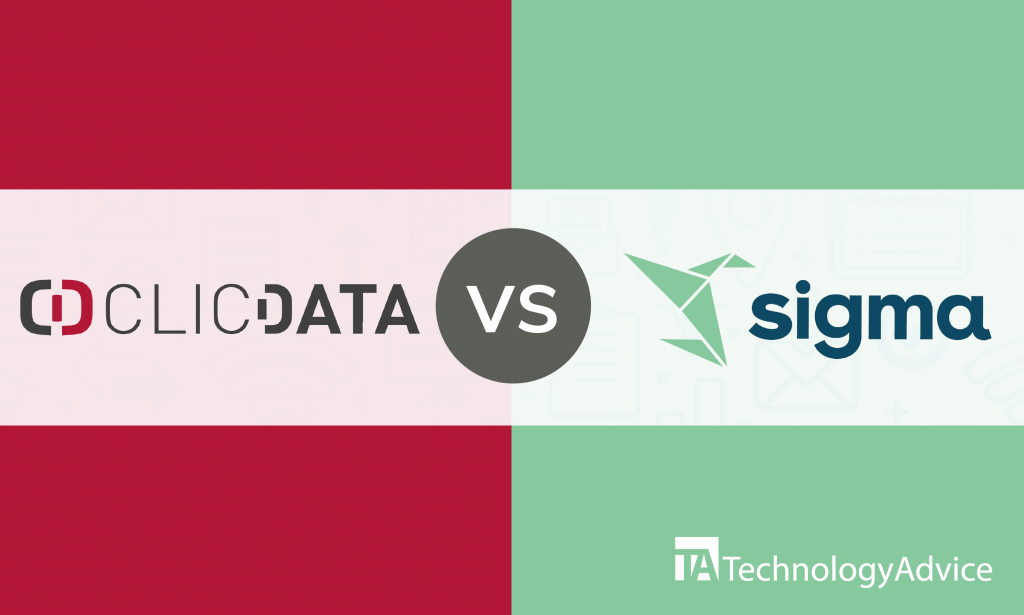- categoryBusiness Intelligence
- ContentComparison
If it’s your first time to look for a business intelligence (BI) software, you probably have come across the big names in the industry such as Sisense, Power BI, and IBM Cognos. While these are great BI software options, they could be challenging to navigate for some users and have high-end pricing. Fortunately, there are less well-known BI solutions with amazing capabilities, like ClicData and Sigma.
ClicData is a user-friendly BI software that helps users develop needed reports and dashboards, using different databases to get complex calculations sorted. Sigma is a fast-rising BI and analytics software, which helps businesses securely connect with data warehouses and visualize data through charts and dashboards.
In this article, we’ll compare the key features of ClicData and Sigma to give you an idea on how each BI software can help you understand business data more easily. If you want to explore more BI solutions on the market, use our Product Selection Tool. You will get a list of five trusted BI software worth considering.
ClicData vs. Sigma: What you need to know
ClicData was founded in 2008 in Lille, France. This cloud-based BI software has intuitive and dynamic reports as well as an extensive array of visualization widgets to give users the control to make better decisions faster. ClicData has features for data management, interactive dashboards, mobile dashboards, reporting, automatic notifications, data visualization, and access control. ClicData has average pricing and is best suited for SMBs.
Sigma is modern cloud-based analytics that provides live access to cloud data warehouses using an intuitive spreadsheet interface that empowers business experts to ask more questions without coding. Sigma’s features include data discovery and visualization, reporting, drill-down analysis, dashboarding, predictive analytics, and scheduling. Sigma has average pricing and is suitable for small, mid-sized, and large companies.
Features comparison
ClicData and Sigma have features for reports, dashboards, and data visualization.
Reports
ClicData allows users to prepare their data before being included in reports. The reports data preparation is completed through ClicData’s ETL (Extract, Transform, Load) feature. Users can customize their reports as they wish to match their brand. Visualizations, such as charts and graphs, can be added to summarize data and present information more clearly. This BI software’s scheduler feature lets users run reports automatically. Users simply need to set the time and frequency they want the reports to be run. Reports can be shared with colleagues via email or as PDF exports.
Sigma also has a reports feature that lets users structure and join their data, calculate formulas, and filter down to the information they want to monitor. Like ClicData, Sigma allows users to customize reports and use data visualizations such as tables and charts. It’s important to note that only the report author or an Admin can edit a report with Sigma. Reports can be manually sent to colleagues or scheduled to be sent to email, a public Slack channel, Google Sheets, or Google Drive automatically.
Dashboards
ClicData has a dashboard designer feature that enables users to transform raw data into insights quickly and easily. Start visualizing performance, trends, forecasts, and results with charts, gauges, indicators, and tables with the drag and drop dashboard designer. ClicData dashboards are automatically refreshed when data is added, deleted, or updated. The system monitors all data sources and refreshes any connected dashboard. Users can zoom in, filter, or drill down to see what they need to see and get more details from the dashboard. Company or customer branding identity can be followed because users can personalize fonts, colors, and background with ClicData.
Sigma’s dashboard feature gives the users the freedom to create custom dashboards and insert their custom visualizations from worksheets, create custom filters, and set how often a dashboard refreshes. Using Sigma’s drag and drop interface, users can rearrange their dashboard and incorporate additional elements and sections to get to the design they desire. This BI has interactive charts that allow coordinated drill downs and highlighting of specific information. Sigma has dashboard templates or pre-built starting points to work with various data sources. This software has a dashboard control functionality that allows end users to set filters and parameters. This feature also offers hidden controls to let the dashboard creator add a permanent filter.
Data visualization
ClicData has a wide selection of data visualizations called Widgets. Users can utilize these Widgets to represent numerical or qualitative data. Widgets for ClicData include date charts, gauges, lists, maps, media, sliders, knobs, funnel chart, waterfall chart, tables, trend lines, and annotations.
Like ClicData, Sigma comes with a set of data visualizations to give voice to the data. Users can choose from line charts, pie and donut charts, pivot tables, single value visualizations, stacked bar graphs. map charts, dual axis charts, trellis graphs, and drill-down charts. Users can also set the background color for the entire visualization and the plotting area of the chart and set a border.
Integrations
Integrations for ClicData include tools for cloud storage, sales automation, time tracking, surveys, and project management:
- Google Drive
- Salesforce Sales Cloud
- TSheets
- SurveyMonkey
- Basecamp
Sigma has integrations with applications for data pipeline, data preparation, inbox management, team communication, and cloud-based spreadsheets:
- Alooma
- Matillion
- Gmail
- Slack
- Google Sheets
ClicData or Sigma?
ClicData and Sigma are both user-friendly, intuitive, and affordable. These BI solutions are good for start ups and average-sized businesses. However, one software will be better than the other, depending on the specific features you want for your business.
ClicData can help you prepare data, which is imperative in ensuring that reports will run smoothly and will display accurate information. ClicData has more integrations than Sigma, too. Sigma, on the other hand, has pre-built dashboards that can be a great deal of help for non-technical users and beginners.
If you’re still unconvinced, use our Product Selection Tool and get a list of other dependable BI solutions.
